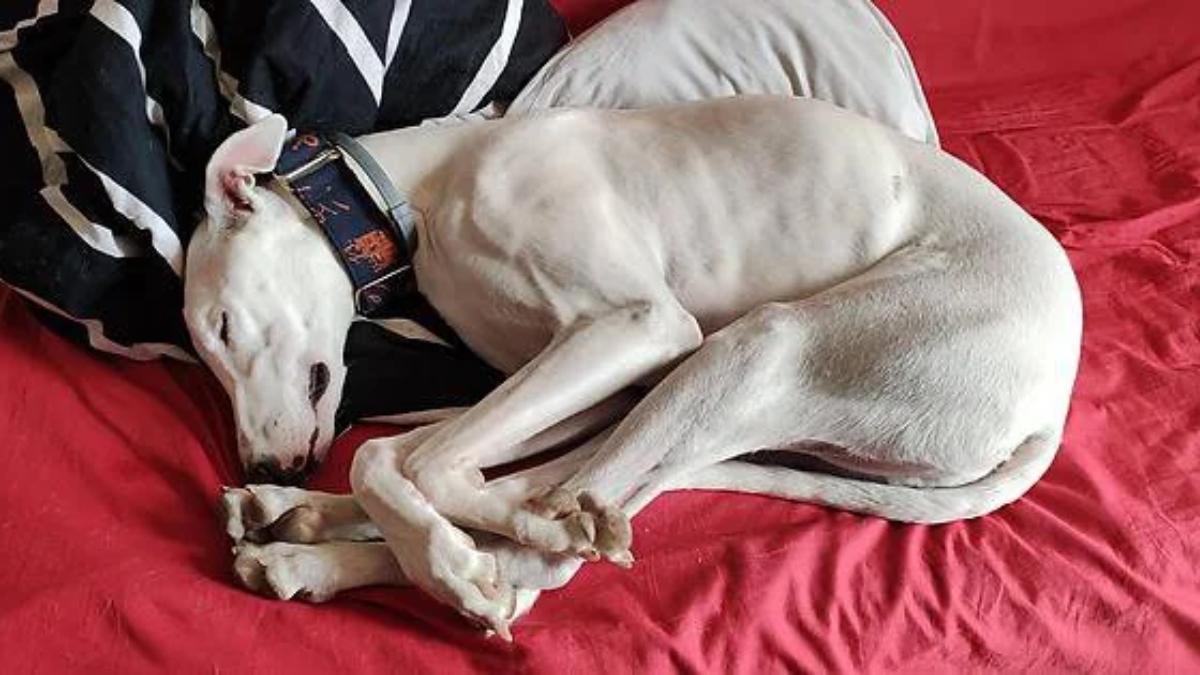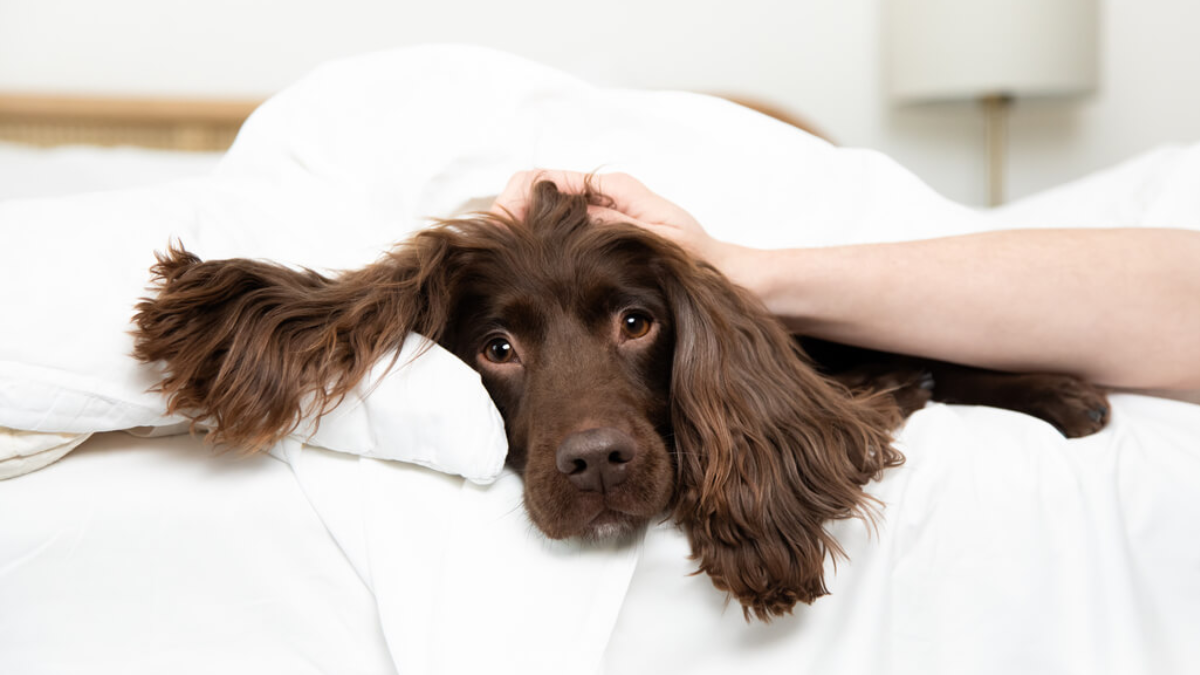"Dogs are known for their love of sleep. They can sleep for up to 12 to 14 hours a day, depending on their age, breed, and activity level. But have you ever wondered what goes on during your dog's sleep cycle? Understanding your dog's sleep pattern, also known as Understanding Your Dog's Sleep Cycle, can help you provide them with the right amount of rest they need."
Just like humans, dogs go through different stages of sleep. There are two main stages of sleep: REM (Rapid Eye Movement) and Non-REM. During REM sleep, dogs may twitch or move their eyes under their eyelids, and they may even make noises. Non-REM sleep is when dogs are in a deeper sleep and their body is more relaxed. Understanding these stages of sleep can help you identify if your dog is getting enough rest or if they are experiencing any sleep disorders.

In this article, we will explore the different stages and patterns of your dog's sleep cycle. We will discuss how much sleep your dog needs, what factors affect their sleep, and how to ensure they are getting the right amount of rest. By understanding your dog's sleep cycle, you can help them live a healthy and happy life.
"Unlock the hidden depths of your dog's sleep patterns with Fi's advanced collar. Designed to empower pet owners with unparalleled insights and control, this collar is a game-changer in canine care. From monitoring your dog's sleep patterns to tracking their every move with live location updates, our collar keeps you connected like never before. With waterproof durability and an extended battery life, it's built to withstand any adventure. And when safety is paramount, our escape alert and lost mode features provide invaluable peace of mind. Understanding your dog's sleep cycle is just one more way Fi enhances your bond. Invest in your dog's health and happiness today – choose our smart collar and embark on a journey of boundless companionship."
The Basics of Canine Sleep
Dogs, like humans, require a certain amount of sleep to stay healthy and function properly. Understanding your dog's sleep cycle is crucial to ensuring that they get the rest they need.
On average, dogs sleep for about 12 to 14 hours per day, although this can vary depending on their age, breed, and activity level. Puppies and older dogs tend to sleep more, while younger adult dogs may require less sleep.
Dogs also have different sleep patterns than humans. They cycle through different stages of sleep, including light sleep, deep sleep, and REM (Rapid Eye Movement) sleep. During REM sleep, dogs may twitch, move their eyes, and even make noises.
It's important to provide your dog with a comfortable and quiet place to sleep, free from distractions and disruptions. Dogs may also benefit from having a consistent sleep schedule, just like humans.
Here are some key points to keep in mind about canine sleep:
- Dogs require 12 to 14 hours of sleep per day on average.
- Puppies and older dogs may require more sleep than younger adult dogs.
- Dogs cycle through different stages of sleep, including light sleep, deep sleep, and REM sleep.
- REM sleep is characterized by twitching, eye movement, and sometimes noise-making.
- Providing a comfortable and quiet sleep environment is important for your dog's rest.

Understanding Sleep Stages in Dogs
Dogs, like humans, experience different stages of sleep. Understanding these stages can help you provide better care for your furry friend. Here are the three main stages of sleep in dogs:
NREM Sleep
NREM (non-rapid eye movement) sleep is the first stage of sleep in dogs. During this stage, dogs are in a light sleep and can be easily awakened. Their breathing and heart rate slow down, and their muscles relax. This stage of sleep is important for physical and mental restoration.
REM Sleep
REM (rapid eye movement) sleep is the second stage of sleep in dogs. During this stage, dogs are in a deeper sleep and their eyes move rapidly. This is when dogs dream, and their brain activity is similar to that of humans during dreaming. REM sleep is important for cognitive restoration.
Wakefulness
Wakefulness is the third stage of sleep in dogs. During this stage, dogs are fully awake and alert. Dogs spend most of their time awake during the day and sleep at night. However, dogs can also take naps during the day.
Understanding the different stages of sleep in dogs can help you provide a comfortable sleeping environment for your furry friend. Make sure your dog has a cozy bed, a quiet place to sleep, and a consistent sleep schedule. This can help ensure that your dog gets the restful sleep they need to stay healthy and happy.
Factors Influencing Your Dog's Sleep Patterns
Understanding your dog's sleep patterns is crucial in ensuring that they get the rest they need. Several factors influence a dog's sleep patterns, including breed characteristics, age considerations, and activity levels.
Breed Characteristics
Different dog breeds have varying sleep requirements. Some breeds, such as the Greyhound and the Bulldog, require more sleep than others. Greyhounds, for example, are known to sleep for up to 18 hours a day, while Bulldogs may need up to 14 hours of sleep.

Age Considerations
Age is also a significant factor that influences a dog's sleep patterns. Puppies and senior dogs tend to sleep more than adult dogs. Puppies require more sleep to support their growth and development, while senior dogs may need more sleep due to age-related health issues.
Activity Levels
A dog's activity level can also affect their sleep patterns. Dogs that are highly active during the day may need more sleep to rest and recover. Conversely, dogs that lead a sedentary lifestyle may require less sleep.
It is essential to note that individual dogs may have unique sleep requirements, and it is crucial to observe your dog's sleep patterns to determine their specific needs. By understanding the factors that influence your dog's sleep patterns, you can ensure that they get the rest they need to stay healthy and happy.
Common Sleep Disorders in Dogs
Dogs, just like humans, can experience sleep disorders that affect their quality of life. Here are some of the most common sleep disorders in dogs:
Insomnia
Insomnia is a sleep disorder that affects dogs as well as humans. This condition is characterized by the inability to fall asleep or stay asleep. In dogs, insomnia can be caused by anxiety, pain, or discomfort. It can also be a side effect of medication or a symptom of an underlying medical condition.
Sleep Apnea
Sleep apnea is a condition in which a dog's breathing is interrupted during sleep. This can be caused by a physical obstruction in the airway or a neurological disorder. Dogs with sleep apnea may snore loudly, gasp for air, or show signs of restlessness during sleep. This condition can lead to fatigue, irritability, and other health problems if left untreated.
Narcolepsy
Narcolepsy is a neurological disorder that causes sudden and uncontrollable episodes of sleep. Dogs with narcolepsy may fall asleep at inappropriate times or during activities such as eating or playing. This condition can be caused by a genetic mutation or an autoimmune disorder. While there is no cure for narcolepsy, medication, and lifestyle changes can help manage the symptoms.
It is important to recognize the signs of sleep disorders in dogs and seek veterinary care if necessary. With proper diagnosis and treatment, most sleep disorders can be managed effectively, allowing dogs to get the restful sleep they need to stay healthy and happy.
Improving Your Dog's Sleep Quality
Dogs need quality sleep just as humans do. To ensure that your furry friend gets the best rest possible, consider implementing the following tips:
Creating a Comfortable Sleep Environment
Dogs are creatures of habit and they need a comfortable and secure place to sleep. Provide your dog with a cozy bed that is the right size for their breed and size. Consider investing in a bed made of memory foam or orthopedic foam for added comfort.
In addition, make sure that your dog's sleeping area is located in a quiet, low-traffic area of your home. This will help to minimize distractions and ensure that your dog can sleep soundly.

Establishing a Routine
Dogs thrive on routine, and establishing a consistent sleep schedule can help to improve their sleep quality. Try to stick to a regular bedtime and wake-up time, even on weekends.
Additionally, make sure that your dog gets plenty of exercise during the day. A tired dog is more likely to sleep soundly through the night.
Diet and Exercise
A healthy diet and regular exercise can also help to improve your dog's sleep quality. Make sure that your dog is eating a balanced diet that is appropriate for their age and breed. Avoid feeding your dog late at night, as this can disrupt their sleep.
Regular exercise is also important for promoting healthy sleep patterns in dogs. Take your dog for a walk or engage in playtime before bedtime to help them unwind and relax.
By creating a comfortable sleep environment, establishing a routine, and focusing on diet and exercise, you can help to improve your dog's sleep quality and ensure that they are well-rested and happy.
Interpreting Your Dog's Sleep Behaviors
Understanding your dog's sleep behaviors is crucial to ensuring their overall health and well-being. While dogs sleep for around 12-14 hours a day, their sleep patterns are different from humans. Here are some common sleep behaviors to look out for and what they might mean.
Dreaming
Dogs are known to dream just like humans. During the rapid eye movement (REM) stage of sleep, dogs may bark, whimper, twitch their legs, or move their eyes under their eyelids. This is a sign that they are in a deep sleep and experiencing vivid dreams. It is important not to wake them up during this stage, as it can be disorienting for them.
Twitching
Twitching is a common behavior during a dog's sleep cycle. It is usually a sign that they are in a deep sleep and their body is relaxed. However, excessive twitching or jerking movements can be a sign of a medical condition. If you notice your dog twitching excessively during sleep, it is best to consult a vet.

Snoring
Like humans, dogs can snore during sleep. While it is usually harmless, loud and persistent snoring can be a sign of a medical condition such as sleep apnea. If you notice your dog snoring excessively, it is best to consult a vet to rule out any underlying health issues.
By understanding your dog's sleep behaviors, you can ensure they are getting the rest they need to stay healthy and happy,. If you have any concerns about your dog's sleep patterns, it is always best to consult a vet for advice.
When to Consult a Veterinarian
While most dogs have a regular sleep cycle, some may experience disruptions due to various health issues. It is essential to keep an eye on your dog's sleep patterns and consult a veterinarian if you notice any of the following:
- Excessive sleepiness: If your dog seems to be sleeping more than usual, it could be a sign of an underlying health problem, such as anemia, hypothyroidism, or diabetes.
- Insomnia: If your dog is having trouble falling asleep or staying asleep, it could be due to pain, anxiety, or other medical conditions.
- Restlessness: If your dog is restless during sleep, it could be a sign of discomfort or pain. It is essential to observe your dog's behavior during sleep to identify any unusual movements or sounds.
- Snoring: While snoring is common in dogs, excessive snoring could be a sign of respiratory problems or obesity.
- Changes in sleep patterns: If your dog's sleep patterns suddenly change, it could be due to an underlying health condition. For example, dogs with cognitive dysfunction syndrome may experience sleep disturbances.
If you notice any of the above symptoms, it is essential to consult a veterinarian. They can help identify the underlying cause of your dog's sleep problems and recommend appropriate treatment. Regular check-ups with a veterinarian can also help identify any health problems before they become severe.

Conclusion:
In conclusion, comprehending your dog's sleep cycle is crucial for ensuring their overall health and well-being. By understanding the stages and patterns of their sleep, you can better cater to their specific needs and address any potential issues that may arise.
Understanding your dog's sleep cycle allows you to recognize when they are experiencing deep, restorative sleep versus lighter, more active sleep phases. This knowledge enables you to create a conducive environment for them to rest undisturbed, promoting better sleep quality and overall health.
Moreover, being aware of your dog's sleep patterns can help you identify any deviations or irregularities that may indicate underlying health issues or discomfort. By monitoring their sleep cycle closely, you can take proactive measures to address these concerns and ensure your furry friend's well-being.
In essence, understanding your dog's sleep cycle empowers you to become a more attentive and responsible pet owner. It allows you to provide them with the care and support they need to thrive physically, mentally, and emotionally.
With the insights gained from understanding your dog's sleep cycle, you can enhance their quality of life and strengthen the bond between you and your beloved companion. So, take the time to learn about and observe your dog's sleep patterns, and watch as they flourish under your attentive care.




